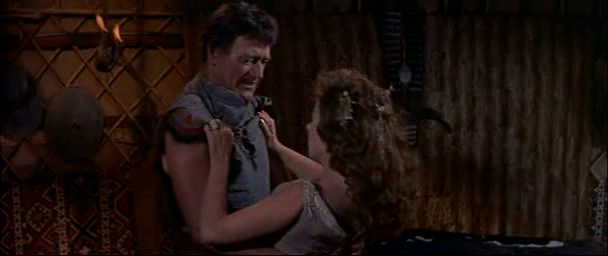|
Genres, Themes, Actors, and Directors:
- Historical Drama
- John Wayne Films
- Lee Van Cleef Films
- Marital Problems
- Ruthless Leaders
- Susan Hayward Films
Review:
“John Wayne as Genghis Khan!” What sounds like a joke is actually a reality, as borne out by this notoriously awful mash-up of westerns and 13th century Mongolian history. According to Hollywood legend, Wayne walked into producer Dick Powell’s office, saw this script in the trashcan, pulled it out, and decided he wanted to have a go at it (and who says no to the world’s top box office star?). Wayne’s flat accent and performance-a-la-cowboy are the first and most obvious sacrificial elements one notices, but there’s plenty more to hoot at: the elaborately colorful and creative “historical” costumes; the florid script by Oscar Millard; the lack of actual Asians playing any of the lead characters; the number of horses that seem to simply topple over during the battle sequences (none were hurt in real life); the surreal dance performance; and the horrifically offensive seduction-through-rape romance depicted between Wayne and Hayward (who thankfully reports she simply laughed hysterically after each take). In addition to being cringeworthingly bad, this film is infamous for its (literally) toxic filming circumstances: three times as many cast and crew participants died of cancer than would normally occur in a population of its size. According to Wikipedia:
Parts of the film were shot in Snow Canyon, Warner Valley, Pine Valley, Leeds, and Harrisburg, Utah. The exterior scenes were shot near St. George, Utah, 137 miles (220 km) downwind of the United States government’s Nevada National Security Site. In 1953, 11 above-ground nuclear weapons tests occurred at the site as part of Operation Upshot–Knothole. The cast and crew spent many difficult weeks at the site, and Hughes later shipped 60 tons of dirt back to Hollywood in order to match the Utah terrain and lend realism to studio re-shoots. The filmmakers knew about the nuclear tests but the federal government assured residents that the tests caused no hazard to public health.
Redeeming Qualities and Moments:
- Many laughably terrible and/or ill-conceived elements


Must See?
I’ll weigh in with a Yes on this train wreck, simply because film fanatics won’t be able to curb their curiosity, and may get some laughs.
Categories
Links:
|
One thought on “Conqueror, The (1956)”
First viewing. A tentative once-must for lovers of camp cinema (and thanks largely to Oscar Millard’s script). The camp factor here is not particularly extensive in the various aspects of the production – but that dialogue! When it’s ‘rich’, it’s very rich indeed! (i.e., “The slaves? Their tongues have been cut out – speak freely.”, though there are more than plenty of examples to choose from.)
As for the storytelling… Within the (shall we say) confines of the screenplay, director Powell can’t really be faulted. It would seem that he set out to acquit himself by sticking to the basics of his own responsibility and making sure that everything looked ok visually. The established tone appears to wed a standard biblical epic to ‘The King and I’. Maybe the worst that can be said of Powell’s efforts is that they result in something a little dry.
Of the actors… Armendariz (surprisingly) comes off best – adding a believable amount of fraternal loyalty. John Hoyt’s sinister performance as the Shaman holds the most ‘entertainment’ value; he’s a bit like Judith Anderson playing Mrs. Danvers in ‘Rebecca’. Most of the other performances lean toward being pedestrian and barely register. As Wayne’s mother, Agnes Moorehead stays in automatic pilot mode in her hatred of Hayward. Hayward herself is mainly admirable in her stoic ability to portray a role comprised of such unlikely and unconvincing mood swings.
Wayne is just BAD – bad bad bad bad bad.
Fave sequence: The Temple Dancers – the choreography here is rather nicely handled (well, until near the end of the sequence – when Hayward attempts a solo that reveals little dancing ability). I always find it a curious thing in historical epics… that, at home, warrior leaders often seem to have their own resident dance troupes.